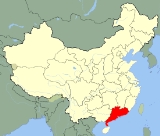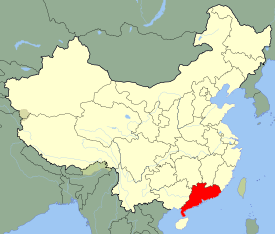
Music of Guangdong
Encyclopedia
In modern times, the Chinese province of Guangdong
has become known for Guangdong music
(later Guangdong folk tunes), a synthesis of a number of local folk music styles (like kunqu
opera), intended as an accompaniment for the region's folk operas when it arose along the Pearl River Delta
in the 1920s. It gradually evolved into a string ensemble format by the 1960s, led by the gaohu
with ruan
, qinqin
, yangqin
, sanxian
, yehu
, and various woodwind
(including houguan
or saxophone
) and percussion
instruments. Formerly, bowed stringed instruments such as the erxian
and tiqin
were used. Compositions by the noted gaohu player Lü Wencheng
(吕文成, 1898-1981) remain particularly popular.
Cantonese opera
is popular in Pearl River Delta
. Musical institutions in Guangdong include the Guangdong International Summer Music Festival.
Teochew music and Teochew opera
is pupular in Chaoshan
.
Hakka music is literary and laid-back in tone, and consists entirely of five notes; many folk songs only use three notes.

Guangdong
Guangdong is a province on the South China Sea coast of the People's Republic of China. The province was previously often written with the alternative English name Kwangtung Province...
has become known for Guangdong music
Guangdong music (genre)
Guangdong music, also known as Cantonese music is a style of traditional Chinese instrumental music from Guangzhou and surrounding areas in Pearl River Delta of Guangdong Province on the southern coast of China. The name of the music is not an accurate description because Guangdong music is not...
(later Guangdong folk tunes), a synthesis of a number of local folk music styles (like kunqu
Kunqu
Kunqu , also known as Kunju , Kun opera or Kunqu Opera, is one of the oldest extant forms of Chinese opera. It evolved from the Kunshan melody, and dominated Chinese theatre from the 16th to the 18th centuries. The style originated in the Wu cultural area...
opera), intended as an accompaniment for the region's folk operas when it arose along the Pearl River Delta
Pearl River Delta
The Pearl River Delta , Zhujiang Delta or Zhusanjiao in Guangdong province, People's Republic of China is the low-lying area surrounding the Pearl River estuary where the Pearl River flows into the South China Sea...
in the 1920s. It gradually evolved into a string ensemble format by the 1960s, led by the gaohu
Gaohu
The gaohu is a Chinese bowed string instrument developed from the erhu in the 1920s by the musician and composer Lü Wencheng and used in Cantonese music and Cantonese opera...
with ruan
Ruan
The ruan is a Chinese plucked string instrument. It is a lute with a fretted neck, a circular body, and four strings. Its strings were formerly made of silk but since the 20th century they have been made of steel...
, qinqin
Qinqin
The qinqin is a plucked Chinese lute. It was originally manufactured with a wooden body, a slender fretted neck, and three strings. Its body can be either round, hexagonal , or octagonal. Often, only two strings were used, as in certain regional silk-and-bamboo ensembles...
, yangqin
Yangqin
The trapezoidal yangqin is a Chinese hammered dulcimer, originally from Middle East and Persia . It used to be written with the characters 洋琴 , but over time the first character changed to 揚 , which means "acclaimed". It is also spelled yang quin or yang ch'in...
, sanxian
Sanxian
The sanxian is a Chinese lute — a three-stringed fretless plucked musical instrument. It has a long fingerboard, and the body is traditionally made from snakeskin stretched over a rounded rectangular resonator. It is made in several sizes for different purposes and in the late 20th century a...
, yehu
Yehu
The instrument comes in various sizes. In Chaozhou music it is a leading instrument, and is tuned quite high. In Cantonese music it can be quite large and is often tuned to a relatively low pitch, lower than the erhu...
, and various woodwind
Woodwind instrument
A woodwind instrument is a musical instrument which produces sound when the player blows air against a sharp edge or through a reed, causing the air within its resonator to vibrate...
(including houguan
Guan (instrument)
The guan is a Chinese double reed wind instrument. The northern Chinese version is called guanzi or bili and the Cantonese version is called houguan . It is classified as a bamboo instrument in the Ba Yin system...
or saxophone
Saxophone
The saxophone is a conical-bore transposing musical instrument that is a member of the woodwind family. Saxophones are usually made of brass and played with a single-reed mouthpiece similar to that of the clarinet. The saxophone was invented by the Belgian instrument maker Adolphe Sax in 1846...
) and percussion
Percussion instrument
A percussion instrument is any object which produces a sound when hit with an implement or when it is shaken, rubbed, scraped, or otherwise acted upon in a way that sets the object into vibration...
instruments. Formerly, bowed stringed instruments such as the erxian
Erxian
The erxian is a Chinese bowed string instrument in the huqin family of instruments. It has two strings and is used primarily in Cantonese music, most often in "hard string" chamber ensembles...
and tiqin
Tiqin
The tiqin is a name applied to several two-stringed Chinese bowed string musical instruments in the huqin family of instruments.-Types:There are several types of tiqin:*The tiqin used for kunqu opera...
were used. Compositions by the noted gaohu player Lü Wencheng
Lu Wencheng
Lü Wencheng was a Chinese composer and musician. He is considered to have been a master of Cantonese music and Guangdong folk music....
(吕文成, 1898-1981) remain particularly popular.
Cantonese opera
Cantonese opera
Cantonese opera is one of the major categories in Chinese opera, originating in southern China's Cantonese culture. It is popular in Guangdong, Guangxi, Hong Kong, Macau, Singapore and Malaysia. Like all versions of Chinese opera, it is a traditional Chinese art form, involving music, singing,...
is popular in Pearl River Delta
Pearl River Delta
The Pearl River Delta , Zhujiang Delta or Zhusanjiao in Guangdong province, People's Republic of China is the low-lying area surrounding the Pearl River estuary where the Pearl River flows into the South China Sea...
. Musical institutions in Guangdong include the Guangdong International Summer Music Festival.
Teochew music and Teochew opera
Teochew opera
Teochew opera or Chaozhou opera, Chiuchow opera , is one of the many variants of Chinese opera, originating in southern China's Chaoshan region. It is popular in eastern Guangdong, southern Fujian, Hong Kong, Macau, Thailand, Singapore and Malaysia...
is pupular in Chaoshan
Chaoshan
Cháoshàn refers to the linguistic and cultural region in the east of Guangdong, a southeastern province of China. This region is the origin of the Min Nan dialect Teochew. The area is known as Teochew for most people overseas, although it also consists of the cities of Shantou and Jieyang...
.
Hakka music is literary and laid-back in tone, and consists entirely of five notes; many folk songs only use three notes.


